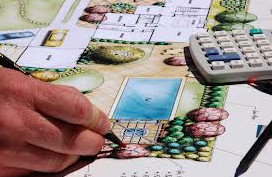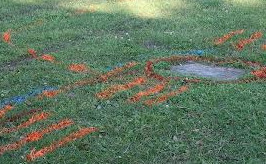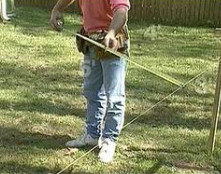When first deciding to landscape your yard, there are some important aspects not to overlook.
Initially, you’ll need to inspect the property.
 |
Things To Look Over and Inspect First
Dispose of any debris such as concrete blocks, glass, sheet rock that may be left over if your home was recently built.
Secondly, you’ll want to survey the existing trees and shrubs in the yard.
Are they healthy?
Do they have pests?
Check large trees for possible damage that may have been left untreated. In some cases, a tree professional may be needed to prune and advise you on how to care for the particular species.
Plantings near the home should be inspected as well, and trimmed as needed. However, major trimming should be avoided during extreme cold or heat. Moderate trimming can be done year round. Remember to trim any overgrown trees and shrubs to allow light to reach plantings beneath. If trimming trees which provide lots of shade is difficult, consider planting plants beneath it which like lots of shade.
Putting Your Plan to Paper
Once you have established your existing plants and trees and the condition of the yard, it’s time to put it all on paper.
For this, two things are needed:
- graph paper
- an accurate survey of the property
Ensure that all aspects are accounted for:
- property boundaries
- doors
- windows
- walkways
- driveways
…as well as gutter downspouts and lower lying areas of the yard.

Determine the location of utility lines, gas lines, electricity and water lines as well.
If you are unsure call our local Houston utility companies and they will assist you in the location of underground lines near your home.
Make Use of Natural Features and Map Things Out
Once this is complete, begin observing the natural features of your yard.
This includes prevailing winds, the suns movement and relation to sunny and shady areas of the yard. Are there areas that seem to get no sun while others get a full days’ worth?
Take note of the slope of the land- after a rain are there areas that flood? Puddle? Dry quickly? Notate these dry and wet spots as well as the sunny and shady spots on your paper.
Next, tape a piece of tracing paper on your diagram and begin drawing suggestions and improvements and ideas. If a mistake is made the original graph is unharmed.

In the yard, utilize stakes and strings to establish possible planting areas. Utilize the aforementioned idea of using garden hoses to lay out potential beds. Remember to allow adequate access to water spigots, and plants that may need fertilizing and tending. Notate how the landscape will look from within the home as well, and make any necessary adjustments.
It’s now time to visit a local nursery or garden center and explore the available plants.
At this point you should be aware of the plants maximum height and size, it’s hardiness and where it will be in your landscape. Calculate the square footage of plants needed as well as their rate of growth and how far apart they should be spaced.
It’s always better to leave more room than you may think you need between plantings. Plants that are planted too close together are at higher risk of pests, diseases and fungus.
Make sure to also take into consideration plant height and blooming seasons. You don’t want to plant spring bulbs that will only be hidden by taller plants in the spring. Take note on which plants are perennial (last all year) and annual (last only a season) and plan your landscape garden accordingly.

